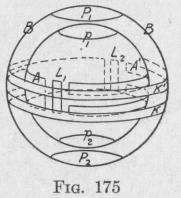224 NAVIGATIONAL COMPASSES
the point of support by attaching to each side of the vertical sup porting ring a compensating mass W, Fig. 174.
§5. The Anschutz Gyro-Compass
135. The Sensitive Element of the Model of 1926. - The firs seaworthy gyro-compass was produced in 1908 by Dr. Herman Anschutz at Kiel, Germany. The model of 1926 has two gyro wheels each with the spin-axle at an angle of about 30 degrees ti the meridian. Each gyro-casing is capable of a slight rotatiot about a vertical axis. The two are connected by geared arcs s, that, when the sensitive element is in equilibrium, the angles ar equal between the meridian and the two gyro-axles.
Until 1926 the sensitive element was supported by a float in vessel of mercury. When this method was used, the turning o
the sensitive element about a vertical axis was opposed by 4a small but unconstant torque due to the surface tension at the mercuryair-metal line of contact. This slight drag is avoided in the model of 1926 by the very ingenious scheme of enclosing the gyro-wheels and damping device in a hermetically sealed spherical globe that is kept poised within an outer spherical shell filled with an electrolyte consisting of a mixture of acidulated water and glycerine. This globe with the enclosed apparatus constitutes the sensitive element.* The sensitive element is slightly pendulous.
The gyro-globe is about ten inches in diameter, and the outer spherical shell has an inside diameter of about ten and one-half inches. Both the globe and the outer spherical shell are made of thin metal. The outside of the gyro-globe and the inside of the spherical shell are covered by a thin layer of hard rubber vulcanized on the metal shells. The gyro-globe has round electrodes, pt, p2, Fig. 175, at the upper and lower poles, and also an equatorial
* U. S. Patent. Anschutz, No. 1589039, 1926.
THE ANSCHUTZ GYRO-COMPASS 225
electrode A, A'. This equatorial electrode is divided by two vertical gaps. One of these halves is further divided into two by a horizontal gap. All three parts are electrically connected. The spherical shell is provided with two polar electrodes Pt, P2, and two ring-shaped electrodes K, K'. The electrodes consist of thin layers of hard rubber charged with carbon and vulcanized on the metal globes. All electrodes are inlaid in the insulating hard rubber coatings of the outside of the gyro-globe, or the inside of the spherical shell, so as to be flush with the spherical surfaces.
The volume of the gyro-globe is such that the weight of the liquid displaced by it is nearly equal to the weight of the globe. Any tendency of the gyro-globe to sink or to move laterally from the central position within the surrounding sphere is prevented by the magnetic force of repulsion developed by the interaction of the magnetic field about an alternate current carrying coil C, Figs. 176 and 177, within the globe, and the magnetic field of eddy currents induced in a conducting saucer-shaped electrode P2 forming part of the lower side of the outer spherical shell. The centralizing coil produces a conical repelling field directed toward the center of the gyro-globe.
The centralizing coil C and the three-phase motor of the two gyros G1, G2, Fig. 177, are joined to the equatorial electrode A and to the two polar electrodes, as indicated in Fig. 176. A threephase current passes from the electrodes P,, P2 and K, K' on the inside of the outer spherical shell, through the thin layer of electrolyte, to the corresponding electrodes P1, P2, and A, A' on the outside of the gyro-globe, Fig. 175.
Lubrication of the moving parts within the gyro-globe is effected by wicks dipping into a pool of oil in the bottom of the globe, x, x', Fig. 177a.
The gyro-globe is exhausted of air and then filled with dry hydrogen at atmospheric pressure. The use of hydrogen instead of air results in several advantages: (a) the oil required for the operation of the apparatus within the globe suffers no chemical change even during months of continuous service; (b) since windage loss is proportional to the density of the surrounding gas, the windage loss with hydrogen is about one-fourteenth that which would occur if the globe were filled with air at the same pressure; (c) since the thermal conductivity of hydrogen is about seven times that of air and the diffusivity is about four times that of air, it follows that

